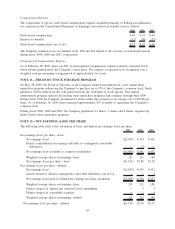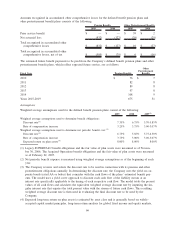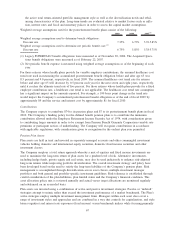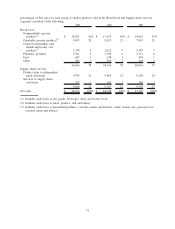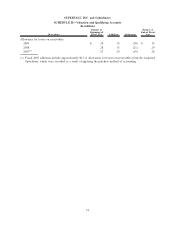Albertsons 2009 Annual Report Download - page 72
Download and view the complete annual report
Please find page 72 of the 2009 Albertsons annual report below. You can navigate through the pages in the report by either clicking on the pages listed below, or by using the keyword search tool below to find specific information within the annual report.
on security selection as a means to add value. Monitoring activities to evaluate performance against targets
and measure investment risk take place on an ongoing basis through annual liability measurements, periodic
asset/liability studies and quarterly investment portfolio reviews.
The asset allocation guidelines and the actual allocation of pension plan assets are as follows:
Asset Category
Target Allocation
Ranges
Plan Assets
2009
Plan Assets
2008
Domestic Equity 30.0% - 55.0% 44.0% 50.9%
International Equity 10.0% - 25.0% 20.3% 16.9%
Fixed Income 20.0% - 40.0% 34.0% 31.7%
Private Equity 0.0% - 7.5% 1.3% 0.0%
Real Estate 0.0% - 15.0% 0.0% 0.0%
Cash and Other 0.0% - 10.0% 0.4% 0.5%
Total 100.0% 100.0%
Defined Contribution Plans
The Company sponsors several defined contribution and profit sharing plans pursuant to Section 401(k) of the
Internal Revenue Code. The total amount contributed by the Company to the plans is determined by plan
provisions or at the discretion of the Company. Total contribution expenses for these plans were $79, $106 and
$83 for fiscal 2009, 2008 and 2007, respectively. Plan assets also include 4 shares of the Company’s common
stock as of February 28, 2009 and February 23, 2008.
Post-Employment Benefits
The Company recognizes an obligation for benefits provided to former or inactive employees. The Company
is self-insured for certain of its employees’ short-term and long-term disability plans, which are the primary
benefits paid to inactive employees prior to retirement. As of February 28, 2009, the obligation for post-
employment benefits was $66, with $23 included in Accrued vacation, compensation and benefits and $43
included in Other liabilities.
Multi-Employer Plans
The Company also participates in several multi-employer plans providing defined benefits to union employees
under the provisions of collective bargaining agreements. These plans require the Company to make
contributions thereto as negotiated in such collective bargaining agreements. The Company contributed $147,
$142 and $122 to these plans for fiscal 2009, 2008 and 2007, respectively. Currently, some of these plans are
underfunded in that the present value of accrued liabilities exceeds the current value of the assets held in trust
to pay benefits. If the Company were to significantly reduce contributions, exit certain markets or otherwise
cease making contributions to these plans, it could trigger a partial or complete withdrawal that would require
the Company to fund its proportionate share of a plan’s unfunded vested benefits. There are many variables
that affect future funding requirements such as investment returns and benefit levels.
Collective Bargaining Agreements
As of February 28, 2009, the Company had approximately 178,000 employees. Approximately 110,000 employ-
ees are covered by collective bargaining agreements. During fiscal 2009, 60 collective bargaining agreements
covering approximately 29,000 employees were renegotiated. During fiscal 2009, 62 collective bargaining
agreements covering approximately 4,500 employees expired without their terms being renegotiated. Negotia-
tions are expected to continue with the bargaining units representing the employees subject to those
agreements. During fiscal 2010, 47 collective bargaining agreements covering approximately 37,000 employees
will expire.
68







